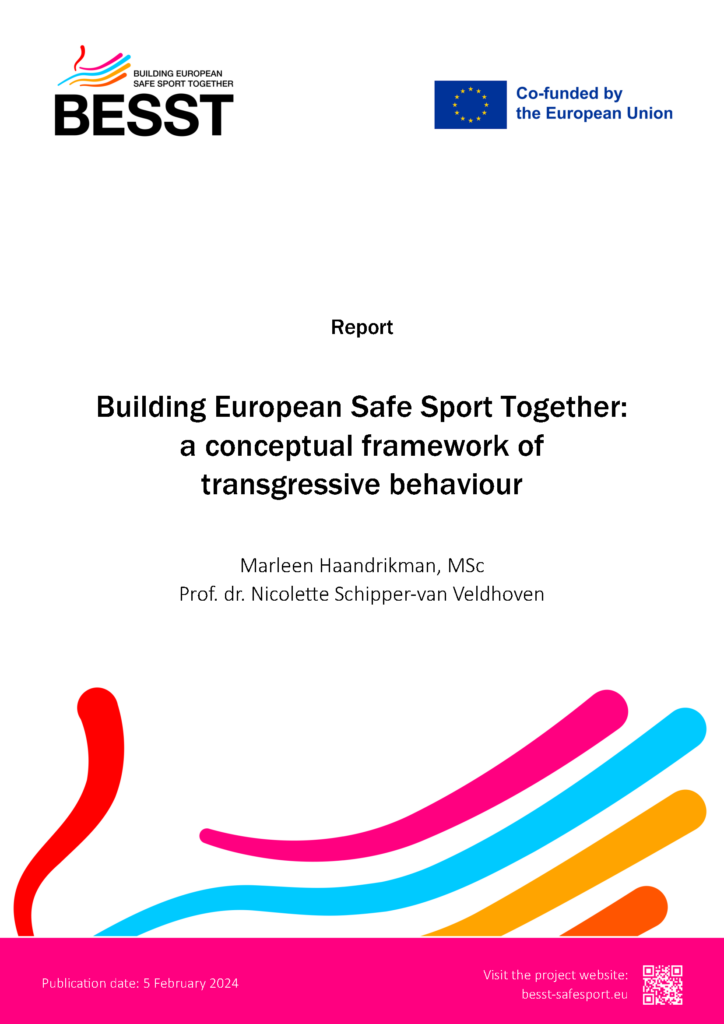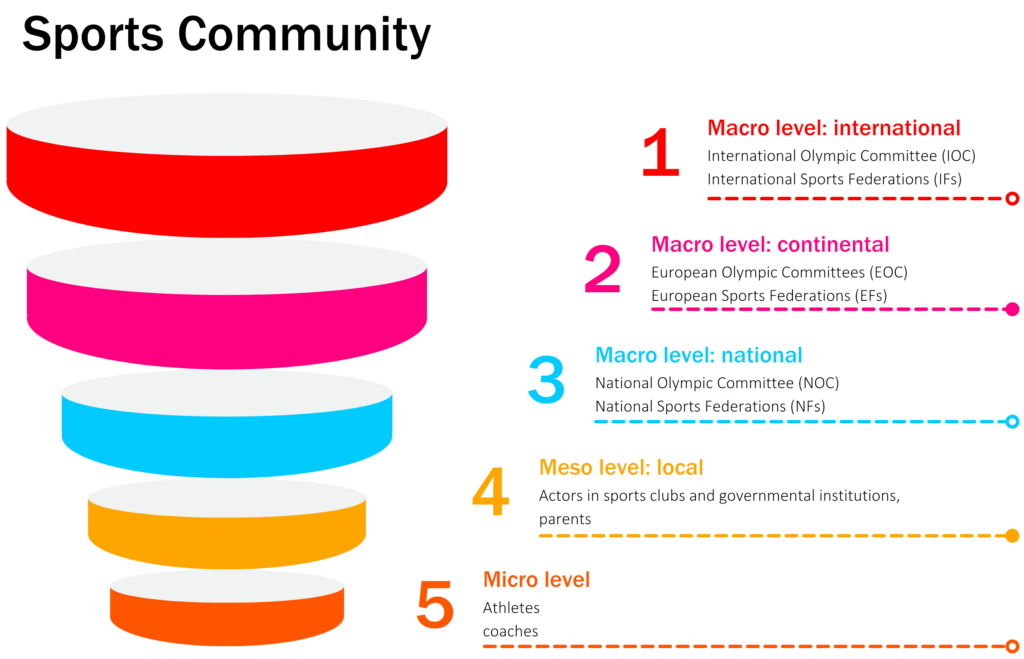Source: NOC*NSF
Building European Safe Sport Together: a conceptual framework of transgressive behaviour
Marleen Haandrikman, MSc 1,3* and Prof. dr. Nicolette Schipper-van Veldhoven 1,2,3,4
1 Research Centre Human Movement and Education, Windesheim University of Applied Sciences, Zwolle, The Netherlands; n.schippervanveldhoven@windesheim.nl
2 Faculty of Electrical Engineering, Mathematics and Computer Science, University of Twente, Enschede, The Netherlands;
3 Faculty of Behavioural, Management and Social Sciences, University of Twente, Enschede, The Netherlands;
4 Netherlands Olympic Committee and Netherlands Sports Confederation (NOC*NSF), Arnhem, The Netherlands;
* Correspondence: m.j.m.haandrikman@windesheim.nl
Corresponding author at Windesheim University of Applied Sciences, Campus 2 Zwolle, Postbus 10090 8000 GB
Zwolle, The Netherlands.

Summary
European citizens’ engagement in physical activities and sports varies by age, gender, and nationality. Despite these differences, participation in sports offers physical, mental and social benefits for everyone, emphasising its value. To boost sports involvement, it is crucial to have actors at micro, meso and macro levels providing opportunities. The micro level involves athletes and coaches, the meso level includes local contributors like sports club board members, and the macro level comprises providers of sports frameworks and policies on national and international scales. In addition to promoting sports, safety is a vital consideration for actors at all three levels. Every individual has a fundamental right to access sports in a secure environment, and the sports community must uphold this right. Unfortunately, unsafe sports environments are prevalent globally, leading to harmful consequences for participants. Harassment and abuse can occur at all levels, necessitating the integration of safeguarding into the sports community’s core principles. Project BESST aims to raise awareness and foster a shared responsibility among all sports actors to ensure a safe environment for everyone in the sports community.

Context-centred approach
Recognising and addressing all forms of harassment and abuse in sports is crucial for fostering a safe community. To achieve this, we should move beyond categorising incidents and instead adopt a holistic approach, focusing on understanding the interpersonal dynamics in which harassment and abuse occur. Project BESST is developing a conceptual framework using a context-centred approach, considering sports ethics to guide ethical behaviour. Sports ethics aim to protect individuals from harassment and abuse, but the abstract nature of “unethical behaviour” creates a grey area. Therefore, it is essential to consider societal standards influencing behaviours leading to harassment and abuse in sports.
Distribution of power
Recognising power dynamics within the sports community, as per Foucault’s theory, is important. Power is viewed as a fluid force shaping behaviour, not fixed to one’s identity. It evolves in social interactions, influenced by communication, leading to established societal standards and accepted ‘truths’. In sports, individuals may assume perceived power based on societal standards, using their identity to assert dominance. To address this, we must focus on identifying power through communication, not institutions or groups. Society has created discourses that marginalise individuals with specific characteristics like age, disability, ethnicity, sexual orientation, and gender in sports, labelling them as ‘space invaders’. Marginalisation occurs when individuals deviate from established standards, creating conditions for harassment and abuse. The societal construction of sexuality, rooted in beliefs and ‘truths’, contributes to these standards. Examples include religious taboos (e.g., opposition to same-sex relationships) and racial purity ideals. These standards, prevalent in patriarchy, cisheteronormativity, and racialisation, extend into the sports community, shaping behaviours at all levels.
Harassment and abuse in sports stem from societal standards that influence the sports community. Patriarchal norms emphasising male dominance contribute to expectations of masculine behaviour, creating issues for and by men in sports. Labelling certain sports as ‘masculine’ or ‘feminine’ reinforces power associations with masculinity, leading to a hierarchy and marginalisation of those not conforming to traditional norms. Cisheteronormative standards further exclude individuals falling outside binary gender identities, causing additional marginalisation. Society’s categorisation of people based on physical characteristics, such as race, results in racialisation, perpetuating the superiority of white ethnicity. These standards, not exhaustive, contribute to transgressive behaviour in sports, shaped by a societal understanding of ‘truth’, which evolves over time.
Theoretical framework
Project BESST offers a framework to help individuals rethink their views on harassment, abuse and safeguarding in sports. It encourages thinking outside the box and avoiding categorisation. The project focuses on understanding how people exert power in sports, considering the context, target, and impact. It promotes a comprehensive perspective on harassment and abuse, defining it as transgressive behaviour (TB), “any form of misuse of relationships of power violating someone’s access to safe sports”. The project recognises three forms of transgressive behaviour – sexual, psychological, and physical – that can overlap and co-occur in the sports community.
Our mission is to create a safe sports environment in Europe, focusing on positive actions rather than negative behaviour. We want everyone to enjoy sports in a secure setting. To achieve this, the sports community needs to be both proactive and responsive, ensuring everyone’s right to access sports safely. Our approach highlights two aspects: the use of power in a positive way (empowerment) and the presence of safeguarding measures. By implementing these principles, we believe that safe sports can be established within the sports community.
“Building European Safe Sports Together” requires collective effort. All stakeholders in the sports community, at every level, should prioritise the safety of individuals involved in sports. Safeguarding should be ingrained in their approach, with each stakeholder sharing responsibility for ensuring safe sports. Achieving this requires a cultural shift in the sports community, emphasising empowerment and leveraging power dynamics in relationships, particularly for marginalised individuals. Rather than categorising behaviours and people, adopting a holistic approach is key to creating safe sports. Let’s collaborate to establish new standards and build European Safe Sports Together.
The project proposes a holistic view of harassment and abuse in sports by defining it as transgressive behaviour (TB) defined as “any form of misuse of relationships of power violating someone’s access to safe sports”.
– Project BESST

